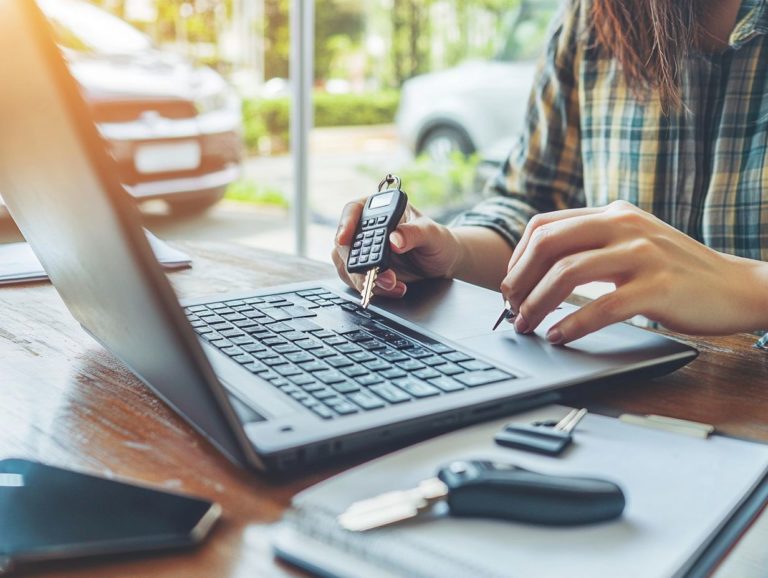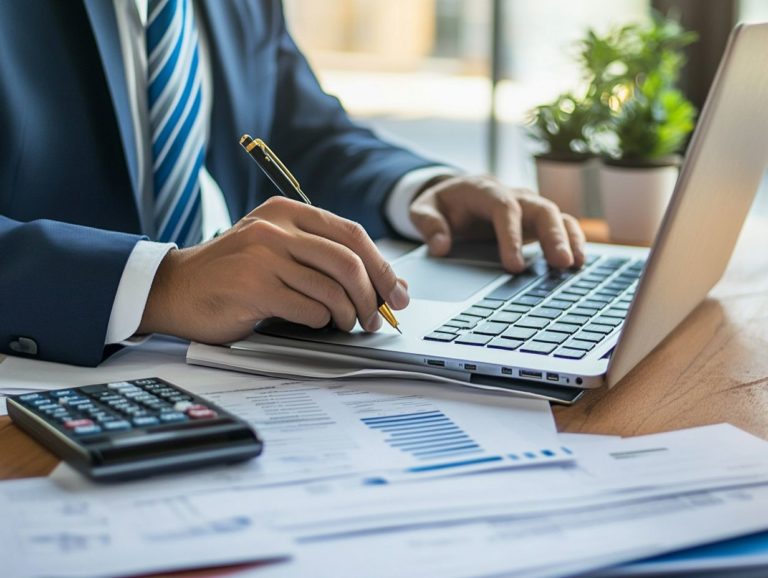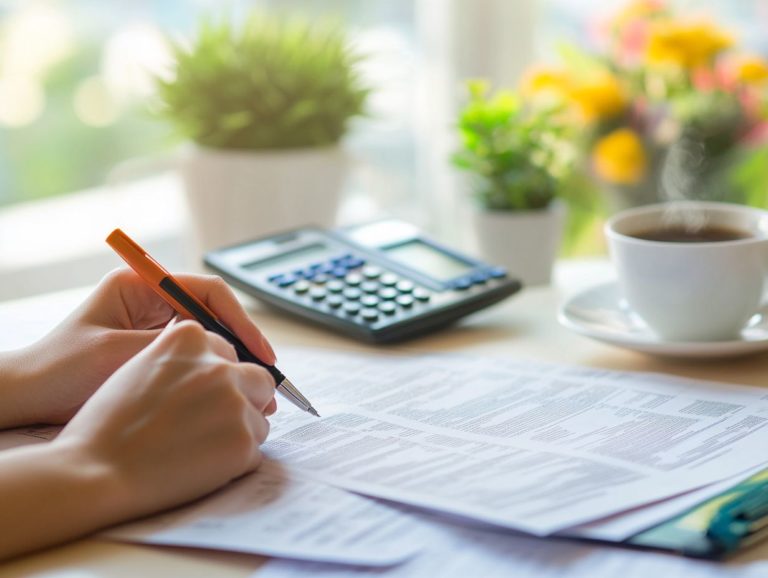Understanding the Lease vs. Buy Decision
Deciding whether to lease or buy can feel overwhelming. There are many factors to consider.
This article explores both options. It clearly defines each and highlights their key differences.
We will discuss critical factors to consider. This will help you make an informed decision that fits your needs.
Whether you’re considering a new car or essential equipment, this guide will illuminate the best path for you.
Contents
Key Takeaways:

- Leasing allows for lower initial costs and flexibility, while buying offers long-term ownership and potential savings.
- Determining cost, usage, and future goals are crucial factors in the lease vs. buy decision.
- Check out the pros and cons of each option to make the best choice for you!
The Basics of Leasing and Buying
Understanding leasing versus buying is essential for business owners. These decisions greatly influence cash flow and your overall strategy.
The choice between leasing equipment like heavy-duty copiers or service trucks and outright purchasing can significantly shape your investment efficiency. This decision also impacts lease accounting standards and tax implications.
By making informed choices in this area, you optimize your operating budgets and ensure alignment with your long-term financial goals.
Definitions and Differences
Leasing involves a rental agreement where you pay for the use of an asset, whereas buying means you outright own that asset. When weighing these two financial strategies, consider their impact on your cash flow and financial statements.
Leasing generally leads to lower initial costs and provides greater flexibility, making it advantageous for businesses that may need to upgrade their equipment frequently.
On the other hand, purchasing can yield substantial tax benefits through depreciation, which is the decrease in value of an asset over time. This is appealing to those interested in long-term investment gains.
The difference becomes even more pronounced when you look at financing methods. Operating leases typically remain off-balance-sheet transactions, while capitalized leases directly influence liabilities and assets, affecting how financial statement users view your company s financial health.
Advantages of Leasing
Leasing presents many advantages for business owners, especially regarding financial benefits and cash flow management. By choosing to lease, you can preserve capital, sidestep hefty upfront costs, and gain greater control over maintenance expenses tied to evolving technology.
Additionally, leasing may offer tax benefits that improve your financial performance.
Financial Benefits

The financial advantages of leasing are considerable, especially for businesses that aim to manage cash flow effectively and comply with lease accounting standards.
By opting for a lease instead of making an outright purchase, you can significantly enhance your liquidity. The tax implications often favor leasing, as your monthly payments may be fully deductible, optimizing your tax position.
Immediate expensing opportunities can also arise, which can be particularly beneficial for startups or businesses undergoing rapid growth.
If you re a tech company in need of the latest equipment, choosing to lease rather than buy allows you to preserve capital while still gaining access to cutting-edge tools.
This strategy helps you avoid large upfront costs and ensures that your business can adapt to evolving needs without disrupting cash flow.
Advantages of Buying
Acquiring assets outright can save you money in the long run and help you avoid some leasing headaches. This approach enables you to build equity and sidestep the potential drawbacks of leasing arrangements.
Let s explore these options together and find the best fit for your needs!
Long-Term Savings and Ownership
Long-term savings and equipment ownership can significantly enhance your financial stability. The total cost of ownership often proves more advantageous without the burden of lease liabilities.
Owning your equipment frees you from recurring lease payments and allows you to build equity over time. This capital can be crucial for your financial strategies, especially when considering the salvage value at the end of the asset’s life. By understanding how these factors interact, you can strategically plan for substantial investments while ensuring your cash flows remain robust.
Ownership also grants you the flexibility to upgrade or modify equipment as needed. This fosters growth and innovation without the extra costs associated with leasing.
Smart ownership decisions can supercharge your business’s financial health!
Factors to Consider When Deciding to Lease or Buy
When weighing the decision to lease or buy, consider several key factors. Think about cost, usage, and your overarching business goals.
These elements are vital in carefully analyzing your lease and buy options to align with your strategic vision.
Cost, Usage, and Goals

Evaluating cost, usage patterns, and business goals is crucial for determining the best approach to asset management, whether it’s through leasing or purchasing.
If you’re running a startup in the tech space, you might lean towards leasing equipment to preserve cash flow and maintain agility. This strategy allows you to adapt swiftly to changing market demands.
Conversely, if you re part of a well-established manufacturing firm, purchasing machinery could prove more beneficial. Ownership often leads to long-term savings and aligns with specific production goals that require having assets outright.
Understanding the frequency of asset usage can significantly impact overall costs. If you only need an asset intermittently, leasing helps you avoid the burdens of maintenance and depreciation.
By meticulously analyzing these factors, you can make informed decisions that align best with your financial health and strategic objectives.
Making the Decision
When considering whether to lease or buy, it s crucial to assess the advantages and disadvantages of each option. This evaluation should include a thorough understanding of their financial implications and how they relate to your overall business strategy.
Pros and Cons Evaluation
Conducting a thorough evaluation of the pros and cons is essential for grasping the financial implications of leasing versus outright purchasing assets.
This assessment illuminates immediate cash flows and ensures that your investments align with your long-term business strategies. For example, leasing can offer you greater flexibility and lower upfront costs, which is particularly beneficial if you’re a startup or running a business with limited capital. On the other hand, buying grants you ownership, allowing you to build potential equity and enjoy various tax benefits.
Consider a tech company that decided to lease high-end equipment compared to a manufacturer that chose to purchase outright. This illustrates how varying financial structures can significantly impact overall operational efficiency and growth trajectories.
Frequently Asked Questions
What is the lease vs. buy decision?

The lease vs. buy decision refers to determining whether it is more beneficial for an individual or business to lease or purchase an asset, such as a car or equipment.
What factors should be considered when making a lease vs. buy decision?
Factors to consider include the duration for which the asset will be used, the cost of leasing versus buying, the terms and conditions of the lease or purchase agreement, and the financial situation of the individual or business.
Evaluate your options carefully to make the best choice for your needs!
Is it better to lease or buy an asset?
There is no clear answer to this question; it depends on your individual circumstances.
Leasing may be more beneficial for short-term use, while buying could be more cost-effective in the long run.
What are the advantages of leasing an asset?
Leasing often requires a lower initial investment and may have lower monthly payments.
It also allows for easier upgrades or changes to the asset. Leased assets may not appear as liabilities on financial statements, which can improve your financial outlook.
What are the advantages of buying an asset?
Buying an asset allows for full ownership and can lead to long-term cost savings.
It offers customization options and the potential to sell the asset in the future. Moreover, ownership can provide a sense of pride and stability.
How can I determine which option is better for me?
To figure out which option suits you best, carefully consider your needs, goals, and financial situation.
Think about usage frequency, cash flow, and tax implications. Consulting with a financial advisor or conducting a cost-benefit analysis can also help you make the decision.
Evaluate your circumstances actively! Explore resources or tools that can guide you in making the best choice.






